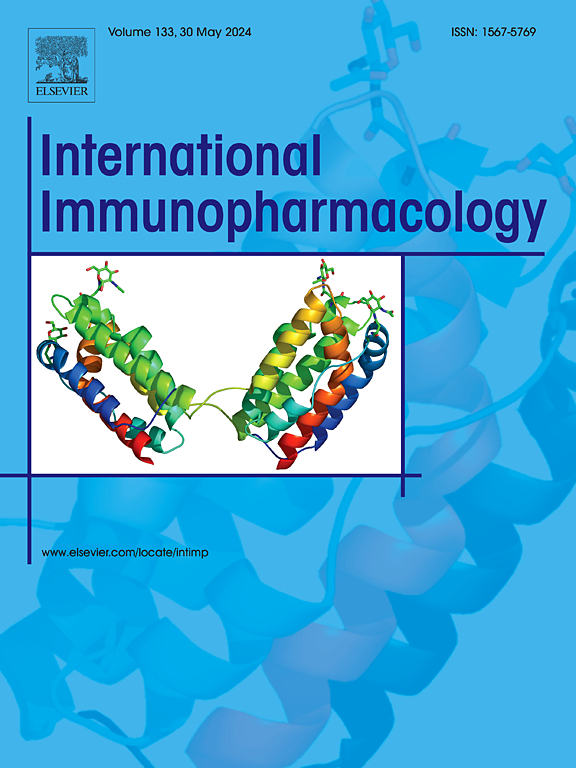Kaempferol improves mitochondrial homeostasis via mitochondrial dynamics and mitophagy in diabetic kidney disease
IF 4.8
2区 医学
Q2 IMMUNOLOGY
引用次数: 0
Abstract
Mitochondrial homeostasis imbalance plays an important role in the development of diabetic kidney disease (DKD). Kaempferol is a key bioactive compound widely present in the rhizomes of Kaempferia L. and vegetables. Its anti-inflammatory and antioxidant properties have gained increasing attention in treating various metabolic diseases. This study investigated whether kaempferol could improve mitochondrial structure and function by regulating mitochondrial dynamics and mitophagy in DKD. A DKD rat model was established via unilateral nephrectomy and streptozotocin injection. Renal function, histopathology, and inflammatory factors were assessed, along with fibrosis, apoptosis, mitochondrial dynamics, and mitophagy-related proteins. Meanwhile, an AGEs-induced HK-2 cell injury model was used to evaluate autophagic flux and mitochondrial function and morphology through ad-mCherry-GFP-LC3B transduction, JC-1 staining, and MitoTracker probes. In vivo results showed that kaempferol exhibited significant anti-inflammatory, anti-apoptotic, and anti-fibrotic effects in DKD rats. Moreover, kaempferol demonstrated good safety by alleviating hepatic fibrosis. It also restored mitochondrial dynamics by promoting the upregulation of mitochondrial fusion proteins (Mfn1, OPA1) and the downregulation of fission proteins (Drp1, Fis1). In addition, kaempferol enhanced mitochondrial biogenesis by upregulating PGC-1α and TFAM. Notably, kaempferol reactivated mitophagy, as evidenced by increased levels of PINK1, Parkin, LC3, Beclin1, and ATG5, along with a reduction in p62 levels. In vitro, kaempferol further demonstrated its antioxidative potential by increasing SOD levels and decreasing MDA levels. Additionally, it promoted autophagic induction and facilitated the fusion of autophagosomes with lysosomes. These combined effects led to the restoration of mitochondrial membrane potential and structural integrity, while reducing ROS production and enhancing ATP generation. In conclusion, kaempferol promotes mitochondrial fusion, restores mitophagy, enhances autophagy flux, and facilitates mitochondrial clearance, showing the potential to mitigate kidney injury and slow disease progression in DKD.
山奈酚通过线粒体动力学和线粒体自噬改善糖尿病肾病的线粒体稳态
线粒体稳态失衡在糖尿病肾病(DKD)的发生发展中起重要作用。山奈酚是广泛存在于山奈属植物根茎和蔬菜中的一种重要的生物活性化合物。其抗炎和抗氧化特性在治疗各种代谢性疾病方面越来越受到重视。本研究探讨山奈酚是否通过调节线粒体动力学和线粒体自噬来改善线粒体结构和功能。采用单侧肾切除术联合注射链脲佐菌素建立DKD大鼠模型。评估肾功能、组织病理学和炎症因子,以及纤维化、凋亡、线粒体动力学和线粒体自噬相关蛋白。同时,通过ad-mCherry-GFP-LC3B转导、JC-1染色、MitoTracker探针检测ages诱导的HK-2细胞损伤模型的自噬通量和线粒体功能形态。体内实验结果显示山奈酚对DKD大鼠具有明显的抗炎、抗凋亡和抗纤维化作用。山奈酚通过减轻肝纤维化表现出良好的安全性。它还通过促进线粒体融合蛋白(Mfn1, OPA1)的上调和裂变蛋白(Drp1, Fis1)的下调来恢复线粒体动力学。此外,山奈酚通过上调PGC-1α和TFAM来促进线粒体生物发生。值得注意的是,山奈酚重新激活了线粒体自噬,PINK1、Parkin、LC3、Beclin1和ATG5水平升高,p62水平降低。在体外,山奈酚通过提高SOD水平和降低MDA水平进一步显示其抗氧化潜力。此外,它还促进自噬诱导,促进自噬体与溶酶体的融合。这些综合作用导致线粒体膜电位和结构完整性的恢复,同时减少ROS的产生并增强ATP的产生。综上所述,山奈酚促进线粒体融合,恢复线粒体自噬,增强自噬通量,促进线粒体清除,显示出减轻肾损伤和减缓DKD疾病进展的潜力。
本文章由计算机程序翻译,如有差异,请以英文原文为准。
求助全文
约1分钟内获得全文
求助全文
来源期刊
CiteScore
8.40
自引率
3.60%
发文量
935
审稿时长
53 days
期刊介绍:
International Immunopharmacology is the primary vehicle for the publication of original research papers pertinent to the overlapping areas of immunology, pharmacology, cytokine biology, immunotherapy, immunopathology and immunotoxicology. Review articles that encompass these subjects are also welcome.
The subject material appropriate for submission includes:
• Clinical studies employing immunotherapy of any type including the use of: bacterial and chemical agents; thymic hormones, interferon, lymphokines, etc., in transplantation and diseases such as cancer, immunodeficiency, chronic infection and allergic, inflammatory or autoimmune disorders.
• Studies on the mechanisms of action of these agents for specific parameters of immune competence as well as the overall clinical state.
• Pre-clinical animal studies and in vitro studies on mechanisms of action with immunopotentiators, immunomodulators, immunoadjuvants and other pharmacological agents active on cells participating in immune or allergic responses.
• Pharmacological compounds, microbial products and toxicological agents that affect the lymphoid system, and their mechanisms of action.
• Agents that activate genes or modify transcription and translation within the immune response.
• Substances activated, generated, or released through immunologic or related pathways that are pharmacologically active.
• Production, function and regulation of cytokines and their receptors.
• Classical pharmacological studies on the effects of chemokines and bioactive factors released during immunological reactions.

 求助内容:
求助内容: 应助结果提醒方式:
应助结果提醒方式:


